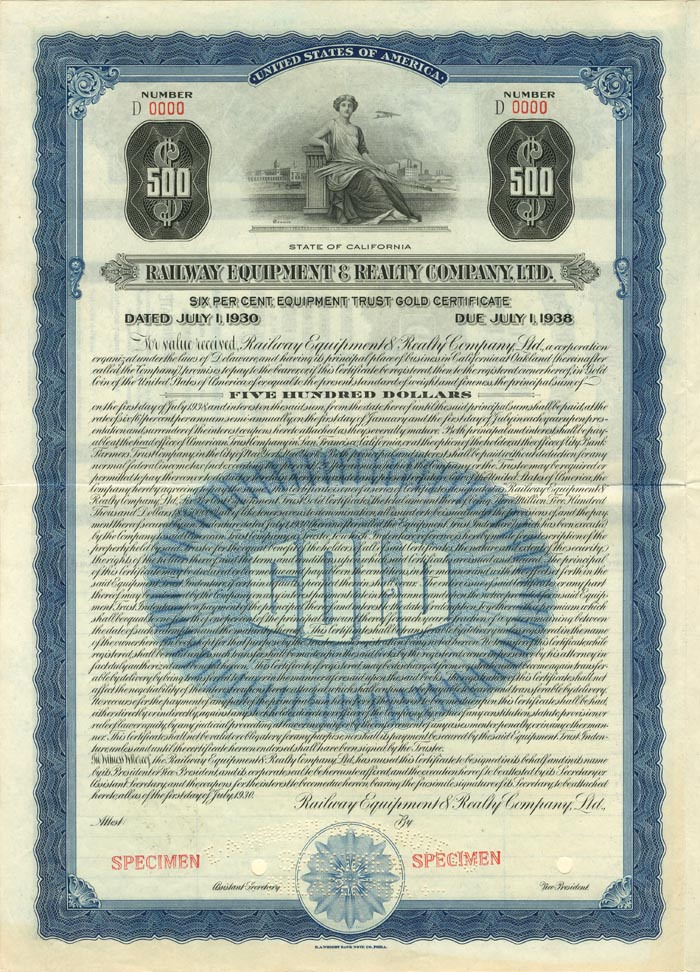Railway Equipment and Realty Co., Ltd. - Specimen Bond
Inv# RB7041 Specimen Bond
$500 Specimen Bond. Very Rare!
Following the Great Crash of 1929, a holding company called the Railway Equipment & Realty Co. was created, with the subsidiary Key System Ltd running the commuter trains. In 1938, the name became the Key System.
The system was a consolidation of several streetcar lines assembled in the late 1890s and early 1900s by Francis Marion "Borax" Smith, an entrepreneur who made a fortune in Borax and earned his nickname, "Borax", and then turned to real estate and electric traction. The Key System began as the San Francisco, Oakland, and San Jose Railway (SFOSJR), incorporated in 1902. Service began on October 26, 1903, with a four-car train carrying 250 passengers, departing downtown Berkeley for the ferry pier. Before the end of 1903, the general manager of the SFOSJR devised the idea of using a stylized map on which the system's routes resembled an old-fashioned key, with three "handle loops" that covered the cities of Berkeley, Piedmont (initially, "Claremont" shared the Piedmont loop) and Oakland, and a "shaft" in the form of the Key pier, the "teeth" representing the ferry berths at the end of the pier. The company touted its 'key route', which led to the adoption of the name "Key System".
In 1908, the SFOSJR changed its name to the San Francisco, Oakland & San Jose Consolidated Railway, changed to the San Francisco-Oakland Terminal Railway in 1912. This went bankrupt in December 1923 and was re-organized as the Key System Transit Co., transforming a marketing buzzword into the name of the company.
During World War II, the Key System built and operated the Shipyard Railway between a transfer station in Emeryville and the Kaiser Shipyards in Richmond.
National City Lines acquired 64% of the stock in the system in 1946.
The same year E. Jay Quinby hand published a document exposing the ownership of National City Lines (General Motors, Firestone Tire, and Phillips Petroleum). He addressed the publication to The Mayors; The City Manager; The City Transit Engineer; The members of The Committee on Mass-Transportation and The Tax-Payers and The Riding Citizens of Your Community. In it he wrote "This is an urgent warning to each and every one of you that there is a careful, deliberately planned campaign to swindle you out of your most important and valuable public utilitiesâyour Electric Railway System".
The new owners made a number of rapid changes. In 1946 they cut back the A-1 train route and then the express trains in 1947. The company increased fares in 1946 and then in both January and November 1947. During the period there were many complaints of overcrowding.
On April 9, 1947, nine corporations and seven individuals (constituting officers and directors of certain of the corporate defendants) were indicted in the Federal District Court of Southern California on two counts: 'conspiring to acquire control of a number of transit companies, forming a transportation monopoly' and 'Conspiring to monopolize sales of buses and supplies to companies owned by National City Lines'. They were convicted of conspiring to monopolize sales of buses and supplies. They were acquitted of conspiring to monopolize the ownership of these companies.
In 1948 they proposed a plan to convert all the streetcars to buses. They placed an advertisement in the local papers explaining their plan to 'modernize' and 'motorize' Line 14. Oakland city council opposed the plan by 5â3. The Public Utilities Commission (PUC) supported the plan which included large fare increases. In October 1948, 700 people signed a petition with the PUC "against the Key System, seeking restoration of the bus service on the #70 Chabot Bus line". The councils of Oakland, Berkeley and San Leandro opposed the removal of street cars. The traffic planners supported removal of the streetcar lines to facilitate movement of automobiles. Local governments in the East Bay attempted to purchase the Key System, but were unsuccessful.
Streetcars were converted to buses during November/December 1948.
In 1949 National City Lines, General Motors and others were convicted of conspiring to monopolize the sale of buses and related products to their subsidiary transit companies throughout the U.S.
Between 1946 and 1954 transbay fares increased from 20¢ to 50¢ ($3 to $5 adjusted for inflation). Fares in this period were used to operate and for 'motorisation' which included streetcar track removal, repaving, purchase of new buses and the construction of bus maintenance facilities. Transbay ridership fell from 22.2 million in 1946 to 9.8 million in 1952.
The Key System's famed commuter train system was dismantled in 1958 after many years of declining ridership as well by the corrupt monopolistic efforts of National City Lines. The last run was on April 20, 1958. In 1960, the newly formed publicly owned AC Transit took over the Key System's facilities.
Most of the rolling stock was scrapped, with some sold to Buenos Aires, Argentina. Several streetcars, interurbans and bridge units were salvaged for collections in the United States. Of the large bridge units, three are at the Western Railway Museum near Rio Vista, California while another is at the Orange Empire Railway Museum in southern California.
Stock and Bond Specimens are made and usually retained by a printer as a record of the contract with a client, generally with manuscript contract notes such as the quantity printed. Specimens are sometimes produced for use by the printing company's sales team as examples of the firms products. These are usually marked "Specimen" and have no serial numbers.









Ebay ID: labarre_galleries